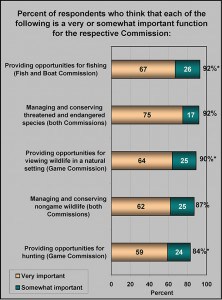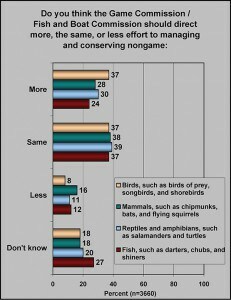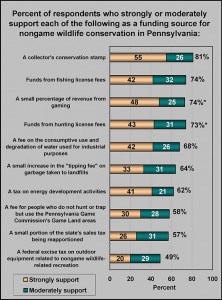Share this article
Survey Shows Residents Care about Nongame Conservation
Pennsylvania residents are concerned about the management and conservation of nongame wildlife species and support a variety of funding sources, according to a new survey conducted for the Pennsylvania Game Commission and the Pennsylvania Fish and Boat Commission.
“This survey was conducted to assess the public’s interest in nongame wildlife and the management of species of greatest conservation need, particularly threatened and endangered species,” said Catherine Haffner, the project lead and a wildlife biologist with the state’s game commission.
It has long been known that some residents favor the conservation of larger, well-known game species. But this study shows that a majority of residents in Pennsylvania also believe the conservation of amphibians, reptiles and other species they can often find near their homes is also important.
Another study conducted by the two commissions in 2005 shows that these nongame species including birds, small mammals and other species, account for 75 percent of the wildlife species in Pennsylvania.
Survey respondents had to indicate how important different functions of the commissions were. Residents were most concerned about the conservation and management of threatened or endangered species and the availability of fishing opportunities. Further, managing and conserving nongame wildlife was somewhat or very important for 87 percent of respondents and very important for 67 percent. In 1996 a similar survey found that only 49 percent of respondents found nongame conservation and management very important.
The survey also asked residents about the importance of more detailed functions of management and conservation and found that addressing wildlife diseases and enforcing wildlife laws were the two most important things for respondents out of a number of more specific categories that also included categories like educating the public about the state’s nongame wildlife. Of these, reintroducing nongame species that once existed in the state found the least support.
In terms of funding for the conservation of nongame wildlife, a majority of respondents supported every source of money except a federal excise tax on outdoor equipment related to nongame wildlife-related recreation. The funding source that the highest number of respondents supported was a collector’s conservation stamp with 81 percent, followed by funds from fishing license fees and a small percentage of revenue from gaming, each at 74 percent. Only 49 percent of respondents supported the excise tax on outdoor equipment related to nongame wildlife-related recreation.
The study, conducted by Responsive Management for the state commissions, was done through telephone surveys of 3,660 residents and spread over all 18 of the Pennsylvania’s congressional districts. The margin of sampling error is a maximum plus or minus 1.62 percentage points.
Haffner said that the survey will go to inform the ongoing revision of Pennsylvania’s State Wildlife Action Plan, “a comprehensive conservation blueprint” to conserve or improve the situation of species of greatest concern and their habitats.
She said the results of the survey will be reflected in the 2015 State Wildlife Action Plan, and that the commission will “strive to increase the public’s awareness of the critical concerns for wildlife through conservation agencies and partners.”
“Wildlife’s future is tied directly to the actions of resource managers and the public. Awareness, education, and public involvement and participation have never been more important.”











